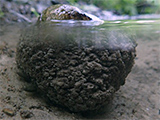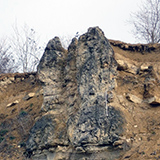Adeline Roche PhD thesis
 Intrinsec and extrinsec controlling factors of microbialites
Intrinsec and extrinsec controlling factors of microbialites
Defended on the 28th August 2020
Funding: doctoral grant, université de Bourgogne Franche-Comté
Supervisor: Emmanuelle Vennin; cosupervisor: Irina Bundeleva
Started in October 2016
Abstract
 The non-marine carbonates related to microbial activity display a large range of morphologies and compositions and accumulate in various settings (freshwater, alkaline, and saline lakes, fluvial environments, thermal and freshwater springs, etc.) The variety of non-marine microbial carbonates and their particularity led to propose numerous and complex terminologies and classifications, making their use complicated and restrictive for the interpretation of depositional settings. Mineralization of these carbonates results from the interaction between biotic factors (intrinsic) and environmental factors (extrinsic and external) at multi-scales. The first aim of this work was to characterize morphologies and compositions of microbial carbonates, through a detailed analysis of these deposits at macro-, meso- and microscales. The second aim was to identify the controlling factors acting on the development and preservation of microbial carbonates. To develop these topics, three examples have been studied: two ancient lacustrine systems: the microbial-metazoan buildups from the Limagne Basin (France), the Pleistocene microbial deposits from the dry Winnemucca Lake (Nevada, USA) and one modern fluvial system: the microbial-tufa of the Mérantaise Valley (France). From these examples, a new classification of the fabrics of microbial deposits ranging from macro to micro-scale has been proposed. Based on descriptive criteria, this classification is helpful for the characterization of microbial deposits and improves the discussion about depositional settings. The study of the mineralized deposits of the Mérantaise Valley and results from microbial culture experiments in the laboratory extracted from the same environment showed the implication of microorganisms in mineralization. The microfabrics from Limagne and Winnemucca Basin reveal a likely biotic origin of these carbonates even if doubt remains on the direct biotic origin in the fossil record. Several environmental factors control the distribution, morphologies, development, and preservation of microbial deposits in the three studied settings: climate and variation of accommodation influence the geometries (at the million- or thousand-years scale) and the microfabrics (seasonal scale), the geodynamic context (tectonics and volcanism) controls the geometry and the distribution of microbial deposits at the basin-scale and faults form drains for fluids circulation. Physico-chemical parameters of waters appear to be a major factor for the mineralization of microbial carbonates. They result from changes in the ion balance depending on surface and sub-surface inputs in these different systems. Finally, the presence of hard and stable substrates improves the mineralization and preservation of microbial deposits and impact their morphologies. To better understand the origin and diversity of non-marine microbial carbonates, a multi-scale approach is crucial to discuss the influence of controlling factors.
The non-marine carbonates related to microbial activity display a large range of morphologies and compositions and accumulate in various settings (freshwater, alkaline, and saline lakes, fluvial environments, thermal and freshwater springs, etc.) The variety of non-marine microbial carbonates and their particularity led to propose numerous and complex terminologies and classifications, making their use complicated and restrictive for the interpretation of depositional settings. Mineralization of these carbonates results from the interaction between biotic factors (intrinsic) and environmental factors (extrinsic and external) at multi-scales. The first aim of this work was to characterize morphologies and compositions of microbial carbonates, through a detailed analysis of these deposits at macro-, meso- and microscales. The second aim was to identify the controlling factors acting on the development and preservation of microbial carbonates. To develop these topics, three examples have been studied: two ancient lacustrine systems: the microbial-metazoan buildups from the Limagne Basin (France), the Pleistocene microbial deposits from the dry Winnemucca Lake (Nevada, USA) and one modern fluvial system: the microbial-tufa of the Mérantaise Valley (France). From these examples, a new classification of the fabrics of microbial deposits ranging from macro to micro-scale has been proposed. Based on descriptive criteria, this classification is helpful for the characterization of microbial deposits and improves the discussion about depositional settings. The study of the mineralized deposits of the Mérantaise Valley and results from microbial culture experiments in the laboratory extracted from the same environment showed the implication of microorganisms in mineralization. The microfabrics from Limagne and Winnemucca Basin reveal a likely biotic origin of these carbonates even if doubt remains on the direct biotic origin in the fossil record. Several environmental factors control the distribution, morphologies, development, and preservation of microbial deposits in the three studied settings: climate and variation of accommodation influence the geometries (at the million- or thousand-years scale) and the microfabrics (seasonal scale), the geodynamic context (tectonics and volcanism) controls the geometry and the distribution of microbial deposits at the basin-scale and faults form drains for fluids circulation. Physico-chemical parameters of waters appear to be a major factor for the mineralization of microbial carbonates. They result from changes in the ion balance depending on surface and sub-surface inputs in these different systems. Finally, the presence of hard and stable substrates improves the mineralization and preservation of microbial deposits and impact their morphologies. To better understand the origin and diversity of non-marine microbial carbonates, a multi-scale approach is crucial to discuss the influence of controlling factors.
Keywords
microbialites, tufas, lacustrine setting, fluvial setting, fabrics, controlling factors
Jury
Frédéric Boulvain, université de Liège, Belgique – reviewer
Rudy Swennen, Katholieke, Universiteit Leuven, Belgique – reviewer
Benjamin Brigaud, université de Paris-Saclay – examiner
Youri Hamon, IFP énergies nouvelles – examiner
Pieter Visscher, University of Connecticut, USA; UBFC – examiner
Emmanuelle Vennin, université Bourgogne Franche-Comté – supervisor
Irina Bundeleva, université Bourgogne Franche-Comté – cosupervisor
Eric Gaucher, Total SA, CSTJF, Pau – invited
Aurélien Virgone, Total SA, CSTJF (Pau) – invited
- extrait:
- lien_externe:
- kc_data:
- a:8:{i:0;s:0:"";s:4:"mode";s:0:"";s:3:"css";s:0:"";s:9:"max_width";s:0:"";s:7:"classes";s:0:"";s:9:"thumbnail";s:0:"";s:9:"collapsed";s:0:"";s:9:"optimized";s:0:"";}
- kc_raw_content:
 Intrinsec and extrinsec controlling factors of microbialites
Intrinsec and extrinsec controlling factors of microbialitesDefended on the 28th August 2020
Funding: doctoral grant, université de Bourgogne Franche-Comté
Supervisor: Emmanuelle Vennin; cosupervisor: Irina Bundeleva
Started in October 2016
Abstract
 The non-marine carbonates related to microbial activity display a large range of morphologies and compositions and accumulate in various settings (freshwater, alkaline, and saline lakes, fluvial environments, thermal and freshwater springs, etc.) The variety of non-marine microbial carbonates and their particularity led to propose numerous and complex terminologies and classifications, making their use complicated and restrictive for the interpretation of depositional settings. Mineralization of these carbonates results from the interaction between biotic factors (intrinsic) and environmental factors (extrinsic and external) at multi-scales. The first aim of this work was to characterize morphologies and compositions of microbial carbonates, through a detailed analysis of these deposits at macro-, meso- and microscales. The second aim was to identify the controlling factors acting on the development and preservation of microbial carbonates. To develop these topics, three examples have been studied: two ancient lacustrine systems: the microbial-metazoan buildups from the Limagne Basin (France), the Pleistocene microbial deposits from the dry Winnemucca Lake (Nevada, USA) and one modern fluvial system: the microbial-tufa of the Mérantaise Valley (France). From these examples, a new classification of the fabrics of microbial deposits ranging from macro to micro-scale has been proposed. Based on descriptive criteria, this classification is helpful for the characterization of microbial deposits and improves the discussion about depositional settings. The study of the mineralized deposits of the Mérantaise Valley and results from microbial culture experiments in the laboratory extracted from the same environment showed the implication of microorganisms in mineralization. The microfabrics from Limagne and Winnemucca Basin reveal a likely biotic origin of these carbonates even if doubt remains on the direct biotic origin in the fossil record. Several environmental factors control the distribution, morphologies, development, and preservation of microbial deposits in the three studied settings: climate and variation of accommodation influence the geometries (at the million- or thousand-years scale) and the microfabrics (seasonal scale), the geodynamic context (tectonics and volcanism) controls the geometry and the distribution of microbial deposits at the basin-scale and faults form drains for fluids circulation. Physico-chemical parameters of waters appear to be a major factor for the mineralization of microbial carbonates. They result from changes in the ion balance depending on surface and sub-surface inputs in these different systems. Finally, the presence of hard and stable substrates improves the mineralization and preservation of microbial deposits and impact their morphologies. To better understand the origin and diversity of non-marine microbial carbonates, a multi-scale approach is crucial to discuss the influence of controlling factors.
The non-marine carbonates related to microbial activity display a large range of morphologies and compositions and accumulate in various settings (freshwater, alkaline, and saline lakes, fluvial environments, thermal and freshwater springs, etc.) The variety of non-marine microbial carbonates and their particularity led to propose numerous and complex terminologies and classifications, making their use complicated and restrictive for the interpretation of depositional settings. Mineralization of these carbonates results from the interaction between biotic factors (intrinsic) and environmental factors (extrinsic and external) at multi-scales. The first aim of this work was to characterize morphologies and compositions of microbial carbonates, through a detailed analysis of these deposits at macro-, meso- and microscales. The second aim was to identify the controlling factors acting on the development and preservation of microbial carbonates. To develop these topics, three examples have been studied: two ancient lacustrine systems: the microbial-metazoan buildups from the Limagne Basin (France), the Pleistocene microbial deposits from the dry Winnemucca Lake (Nevada, USA) and one modern fluvial system: the microbial-tufa of the Mérantaise Valley (France). From these examples, a new classification of the fabrics of microbial deposits ranging from macro to micro-scale has been proposed. Based on descriptive criteria, this classification is helpful for the characterization of microbial deposits and improves the discussion about depositional settings. The study of the mineralized deposits of the Mérantaise Valley and results from microbial culture experiments in the laboratory extracted from the same environment showed the implication of microorganisms in mineralization. The microfabrics from Limagne and Winnemucca Basin reveal a likely biotic origin of these carbonates even if doubt remains on the direct biotic origin in the fossil record. Several environmental factors control the distribution, morphologies, development, and preservation of microbial deposits in the three studied settings: climate and variation of accommodation influence the geometries (at the million- or thousand-years scale) and the microfabrics (seasonal scale), the geodynamic context (tectonics and volcanism) controls the geometry and the distribution of microbial deposits at the basin-scale and faults form drains for fluids circulation. Physico-chemical parameters of waters appear to be a major factor for the mineralization of microbial carbonates. They result from changes in the ion balance depending on surface and sub-surface inputs in these different systems. Finally, the presence of hard and stable substrates improves the mineralization and preservation of microbial deposits and impact their morphologies. To better understand the origin and diversity of non-marine microbial carbonates, a multi-scale approach is crucial to discuss the influence of controlling factors.Keywords
microbialites, tufas, lacustrine setting, fluvial setting, fabrics, controlling factors
Jury
Frédéric Boulvain, université de Liège, Belgique – reviewer
Rudy Swennen, Katholieke, Universiteit Leuven, Belgique – reviewer
Benjamin Brigaud, université de Paris-Saclay – examiner
Youri Hamon, IFP énergies nouvelles – examiner
Pieter Visscher, University of Connecticut, USA; UBFC – examiner
Emmanuelle Vennin, université Bourgogne Franche-Comté – supervisor
Irina Bundeleva, université Bourgogne Franche-Comté – cosupervisor
Eric Gaucher, Total SA, CSTJF, Pau – invited
Aurélien Virgone, Total SA, CSTJF (Pau) – invited
